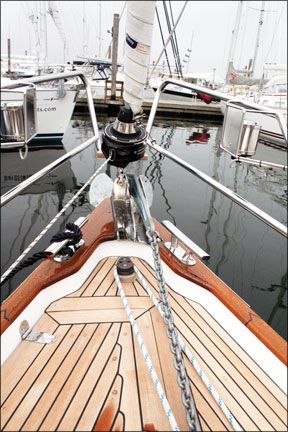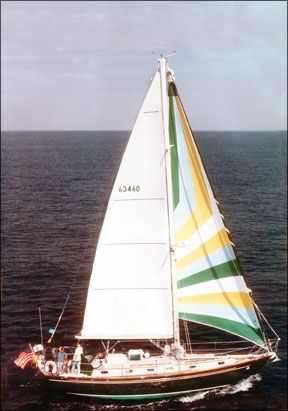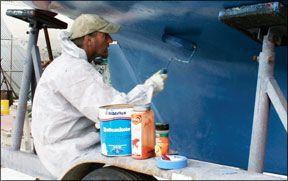Rode Warrior Thank you for your excellent article on heat-related failures of nylon line (“Nylon Rope Endurance Test,” December 2007). When a boat winds up on the beach after a storm, its easy to look at the frayed ends of a mooring line and announce that it had chafed. Your study reinforced what our claims experience has been with nylon mooring and anchor lines in storms: Failures are more likely to be caused by heat than abrasion. Our claims experience at BoatU.S. has been that mooring or anchor lines are most likely to fail between the foredeck cleats and chocks. A line that is compressed at the chock under storm load loses up to half its strength. At the same time the line is being compressed, it is also being stretched back and forth across the chock, which creates tremendous heat. The farther the cleat is from the chock, the more 288 the line will stretch and generate heat. As you noted in your article, canvas or polyester sleeves, which allow water to wick through to the stressed nylon fibers, are the best choice for chafe protection in a storm. An alternative is to install a bow cleat directly on the rail, thereby eliminating the need for a chock. This is being done on many new production boats and, aside from eliminating the need for chafe protection, it has the added benefit of giving the boat a cleaner, more usable foredeck. An even better solution for storm pendants is to install a heavy bow eye (properly backed) near the waterline. The bow eye significantly reduces the possibility of heat- Bob Adriance Editor, BoatU.S. 
related failure and also lowers the angle of pull, which has the same effect as increasing scope. Finally, with any boat, the more lines that are led to the mooring ball (or anchors), the greater the likelihood that at least one will survive the storm intact.
Binocular Eyecups
When I bought my West Marine Raiatea binoculars (“Binoculars Under $300,” August 2006), I was assured by my local West Marine store that the fold-down eyecups were replaceable. They have cracked, and I expect they will soon fall off. Now, according to the store, they can’t get replacements. They did, however, send me new lens covers-not what I needed. In my experience, fold-down eyecups always fail after a few years.
Bruce Barber
Annandale, Va.
It is our understanding that West Marine often provides replacement parts at little or no charge to its customers, but the company hasn’t had any customer feedback suggesting a need to stock eyecups for the Raiatea binoculars. Nevertheless, it soon will have a ready supply for those
who need replacements. Anyone looking for eyecups for their Raiatea binos should contact West Marine customer care 800/685-4838.
Garmin Support?
I read with interest Ed Giles testimonial in your September 2007 issue about Garmin repairing for free a 10-year-old GPS48 that had a problem with the recharging circuitry or internal battery because that problem is common to that particular model. I too have this model with this very same problem, but Garmin refused to repair mine for free because there has been no recall for this problem, and it is not under warranty.
Larry W. Propes
Morgan 27
Columbia, S.C.
Judging by reports on the Internet and the e-mail we are getting in the wake of Mr. Giles letter, it appears that the factory-installed batteries that power the internal memory of the older Garmin GPS48s are reaching the end of their life cycle. While Mr. Giles had success getting his out-of-warranty unit repaired at no charge, others have not. In our view, a products usable life should not be limited to that of its internal battery, and battery replacement cost should be reasonable. The internal battery issue is widespread. A few years ago, an entire line of expensive 406 EPIRBs were rendered obsolete when their batteries expired and replacement cost was more than a new unit. Though it is no consolation to owners of older units, the newer generation Garmins don’t rely on an internal battery.
Tough Passport
In regard to your survey of tough fiberglass boats, Id like to add to the list my

288
Robert Perry-designed Passport 40.
Rapture, hull No. 59, was built for me in 1984. Construction was handlaid solid fiberglass with an internal, 9,000-pound encased keel. Besides all the well-designed and very solid construction details that I could outline, it seems that the best way to impress your readers is to compare by example.Years ago when visiting Oxford, Md., my wife and I approached the dock, bow on. Going by our usual drill, I jumped off, line in hand, ready to bring
Rapture alongside. But signals crossed, and soon Rapture, at full speed, was reversing. Then, just as quickly, Rapture was returning, bow first, full speed headed for the dock…and me! After the abrupt impact (which left only a tiny cosmetic scratch on Rapture), I sheepishly stepped aboard, took the helm and silently left, watching a heavily constructed wood-plank dock fall silently into the bay.Christopher Love
Rapture, Passport 40
Miami, Fla.
The lines are still open in our search for strong FRP boats. Send your nominees in an e-mail to practicalsailor@belvoirpubs.com.
Mooring Gear
In regard to your ongoing chain test and the possible interaction between the stainless and galvanized chains: For many years at my yacht club, moorings in a certain area (mine included) corroded very quickly compared to those in other areas in the mooring field. I was told that it was due to a sunken boat in that area that had stainless steel tanks on board. After a number of years, the situation has improved. In addition, for a while, I inadvertently used a stainless steel thimble on my painter and the galvanized swivel at the top of the mooring chain that the thimble joined to had to be replaced every year or so. Both these cases sound like galvanic action between the stainless and mild steel.
I have two moorings: one at the Savin Hill Yacht Club in Boston (which is where the early corrosion took place due to the sunken boat), and one here in Hull, Mass., on the Weir River (which is almost all salty and very tidal). The mooring at the club is quite standard. Bottom to top, mushroom, -inch chain, shackles, -inch chain, swivel, float and painter. In Hull, I have a Bahamian mooring. This is an upside down “Y” with a 350-pound mushroom offshore and a 250-pound mushroom inshore. I am on the edge of a river where depth is a problem, so I do this to reduce the swing and keep my 6-foot keel out of the mud.
Chuck Moore
Metalmast 30
Hull, Mass.
For more on the interaction between stainless and galvanized steel in mooring and anchoring applications, see the discussion of metallurgy in marine anchors on page 22 this month. An update on our chain test is due this spring.
Walker Bay Report

288
I just got my December issue and turned the Walker Bay Genesis article. I was a little surprised to see your dimensions for the Deluxe are not the same as the Light version when folded. There is no difference.
Also, you noted that installing bridle tow eyes in the hull is not an easy modification. Why? It is not any harder and may be easier, depending on placement, than doing the same to a fiberglass or aluminum hull. The same is true for tube attachments-no different than other brands of similar fabrics.
On a different point, Walker Bay uses stainless-steel hinges to join the aluminum extrusion that is the transom to the polypropylene hull-not between the transom and the tubes. The transom-to-tube connection is actually bolted on.
Jeff Going
Eastern Sales Manager
Walker Bay Boats
The folded dimensions for the Deluxe model were those taken by our tester, while those for the Light were supplied by Walker Bay. Compacting the folded Deluxe with straps would likely achieve the same dimensions as stated by Walker Bay. According to the one installer we spoke with, adding bow eyes in one optimal location requires gaining access on the inside of the hull behind the bow locker, something which is not an issue on some other RIBs. There are alternative locations for bow eyes that are easier to access. The nature of the tube-transom connection should have been made clearer.
LED-Radio Interference
I recently bought two LED bulbs from Euro Marine Trading to replace the incandescent bulbs in my Aqua Marine bow and stern light. The approximate cost was $100. When turned on, these bulbs (I do not recall the brand) interfered with my VHF radio, whose antenna is at the masthead, 57 feet above the water. When I contacted Euro Marine, they acknowledged the problem and said the bulb manufacturer will have a new product shortly that will not cause interference. By comparison, Orca Green Marine, whose masthead tricolor seems to have the same problem, told me how to fix the problem and even offered to trade my unit for a redesigned unit when it became available later this year.
I think this is a common problem. I talked to a marine electronics/electrical installer in Nova Scotia last summer who said he is replacing several different recently installed LEDs with incandescents because of radio interference.
I also have Sailor Solutions interior Sensibulb LEDs (November 2007,) that you have previously profiled and they are wonderful. Bright, natural, about one-fifth the draw of standard bulbs, and no interference.
Mike Ryan
Fiona Rois, Cape Dory 45
Bass Harbor, Maine
According to Keith Simpson of the well-stocked LED Shop Online (
www.ledshoponline.com) in Australia, this problem has been reported on a variety of LED light products, both interior and exterior. Said Simpson: “There would be some interference being that the LED lights have constant current drivers-some boats run suppressors to eliminate this problem. Strangely enough, we never had any problems with automotive applications. Cars have very good suppression of radio interference. We use our SMT bulbs for internal lighting in vehicles without any problem, and we have heard already from one customer that the same bulb causes interference on his boat. He has since fitted suppressors to his boat, and the problem is gone. Why don’t boats have much better radio interference suppression capabilities? I would find this to be more important on a boat than on a car.”Pick-a-Peppered Paint?
I really liked your myth buster article on reflective tapes (November 2007). Heres another one for you: Ive come across Internet reports that adding cayenne pepper to bottom paint will help keep the barnacles off. I recently read one account that using regular house paint with pepper in it worked. How about a test of adding cayenne pepper to bottom paint?
Ed Kukla
St. Clair Shores, Mich.
Over the years,
Practical Sailor has tested a variety of these magical bottom paint additives, ranging from cayenne pepper to diaper ointment. So far we have been unable to find irrefutable proof that these additives work. Nevertheless, we recently engaged the services of Mike Collins (below), fellow Sarasota Sailing Squadron member and keeper of the shark tanks at Mote Marine Aquarium (www.mote.org) to once again evaluate the anti-fouling performance of cayenne pepper.Vinyl Cleaner
I have red and blue stains from plastic flags on our vinyl cushions and have tried everything and nothing has worked. I read the article where you tested vinyl cleaners (February 2006). None of these seem to be strong enough. Can you direct me to something that might help?
Patsy Cline
Via e-mail
Vinyl is extremely porous, so the staining agent can get deep into the material. We had a similar dye stain on the vinyl cushions in one of our test boats. As bottles of mildew cleaners began arriving at our office for an upcoming test, we were curious whether these might remove the stain. We tried one, Star brite Mildew Stain Remover. It didnt completely erase the stain, but made it far less noticeable. According to Jeff Tieger at Star brite, the product migrates into vinyl pores and safely lifts out stains. For tough stains, several applications may be necessary. He warned that some cleaners contain solvents that can remove stains, but they can dry out the plasticizers in the vinyl, eventually causing the vinyl to crack.


































